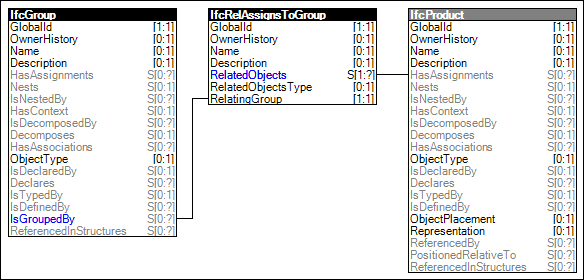
Figure 95 — Group Assignment
Group Assignment established an arbitrary collection of objects within a group. The grouping relationship does not apply any other meaning then grouping objects under some aspect. It is non-hierarchical, that is objects can be grouped into different logical groups, and it does not interfere with other relationship concepts, such as ObjectAggregation.
The Group Assignment concept establish a given object as being the group collection for other objects. An IfcZone is a specific group object for collecting spaces, IfcDistributionSystem is a specific group object for collecting distribution elements. Usually a grouping relationship is applied to group elements for a particular purpose or function. It usually implies the existence of a grouping relationship and the provision of some identity under which the group is characterized.
NOTE The IfcGroup maybe not yet have a grouping relationship established, it then identifies an empty group.
EXAMPLE An air handler belonging to an air conditioning system is an example of such group assignment.
Figure 95 illustrates an instance diagram.
 |
Figure 95 — Group Assignment |
<?xml version="1.0" encoding="utf-8"?>
<ConceptTemplate xmlns:xsi="http://www.w3.org/2001/XMLSchema-instance" xmlns:xsd="http://www.w3.org/2001/XMLSchema" uuid="f567967f-5493-44d9-ac51-937c09ac2583" name="Group Assignment" applicableSchema="IFC4" applicableEntity="IfcGroup">
<Rules>
<AttributeRule RuleID="IsGrouped" AttributeName="IsGroupedBy">
<EntityRules>
<EntityRule EntityName="IfcRelAssignsToGroup">
<AttributeRules>
<AttributeRule RuleID="RelatedObjects" AttributeName="RelatedObjects">
<EntityRules>
<EntityRule EntityName="IfcProduct" />
</EntityRules>
</AttributeRule>
</AttributeRules>
</EntityRule>
</EntityRules>
</AttributeRule>
</Rules>
</ConceptTemplate>